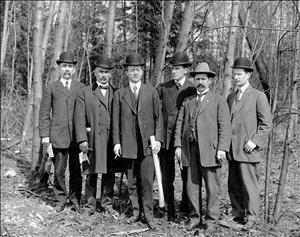On June 1, 1907, Alaska-Yukon-Pacific Exposition groundbreaking ceremonies are held at the south end of the University of Washington campus. Similar to a World's Fair, the exposition was mandated by the Washington State Legislature to display the resources, products, and advantages of Washington and the region. One hundred acres of old-growth Doug-firs are cut down to make way for the fairgrounds.
Between Town and Gown
Flush with pride over the recent growth of their city, Seattle boosters determined that hosting a world’s fair would be the best way to show off the region’s wealth, resources, and advantages. Promoters planned on opening the exposition in 1907 to coincide with the 10th anniversary of the Klondike Gold Rush but discovered that this would conflict with Jamestown, Virginia's plans for its own summer-long tercentenary exhibition.
The Alaska-Yukon-Pacific Exposition was rescheduled to 1909, which gave planners two more years to raise funds, gather participants, prepare exhibits, and lay out the fairgrounds. A 260-acre portion of the University of Washington campus was chosen for the site due to its proximity to downtown, and its breathtaking views of the Cascades, the Olympics, and Lake Washington. The University would also gain some new buildings and landscaped grounds -- a bonus that greatly outweighed complaints that liquor would not be allowed at the fair, since it was prohibited on campus.
Proud and Rowdy
Groundbreaking ceremonies were held on June 1, 1907, exactly two years before opening day. More than 15,000 Seattleites were in attendance, and they were very excited -- almost too excited. After various dignitaries dug up clods of earth, someone called out to let a native son do his share. A man came out of the crowd, grabbed the gold-painted pick, broke ground, and then darted back into the crowd with the pick as his souvenir. As officials tried to get it back, someone else swiped the gilded shovel.
At this point all hell broke loose. The crowd surged forward, filling their pockets and purses with clumps of soil. From there, they lunged toward the grandstand, grabbing for bunting and ribbons. One woman scrambled up the side and ripped off handfuls of small flags, tossing them to her children below. The stage was picked clean save for the large flags that would later fly at the fair.
The fair opened on June 1, 1909, and ran for 138 days. More than three million visitors attended, contributing significantly to Seattle's economic development.

